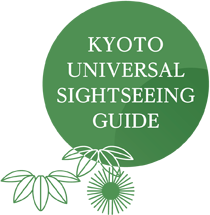【Town Tour】
Historic Course

Koboin remains
Shinsen-en Garden
Moto-Rikyu Nijo Castle
Dairi Hall for State Ceremonies site
Kyoto ASNY
Nijo Castle film studio site
Start!
JR Sagano Line NIjo Station
-

[Universal (Ostomate)] Toilet inside
(beyond tkt barrier) JR Nijo Sta.
Shinsen-en Garden
-
Shinsen-en Garden was created for the emperor and nobles to enjoy, but it is said that it became To-ji Temple of the Shingon sect after Kukai (monk who became abbot of To-ji) and Jubin (abbot of Sai-ji) competed in rituals to make rain fall, which Kukai won. And, although regarded as a temple, Inari-jinja s hrine w ith s mall S hinto s hrines d eifying Benten-san can be f ound in the grounds. And, there is another shrine, with an Eho shrine (favored direction shrine), which is the only one in Japan that has its position changed to the favorable one of the year concerned. 
Public toilet near outermoat ▶See details
Moto-Rikyu Nijo Castle
-
This castle was built by Ieyasu Tokugawa in 1603. The third shogun Iemitsu moved the remnants of Fushimi Castle here and extended the castle to its present size. It runs approximately 500 meters east-west and 400 meters north-south, and is surrounded by a moat. Toward the end of the shogunate, the castle was used as barracks for troops loyal to the shogun. And, it was here that Yoshinobu Tokugawa, the last shogun, announced the restoration of imperial rule. The Ninomaru palace complex (national treasure) is a representative example of samurai shoin-zukuri, or traditional style of Japanese residential architecture. The painting of pine tree and hawks by Tanyu Kano in the Yonnoma room is famous. The cherry blossoms too are famous and are illuminated at night each year. The castle was registered as a World Heritage Site in 1994. If requests are made at the entrance, wheelchair users can enter the Ninomaru palace complex (see the item on Ninomaru for details).

Toilet near Nishibashi bridge in Nijo Castle 
Toilet near Seiryu-en Garden in Nijo Castle 
Toilet near Midori-no-sono in Nijo Castle 
Public toilet at Nijo Park ▶See details
Yamanaka Cooking Oil Co., Ltd.
-
Yamanaka Cooking Oil nestles under its wooden sign on the north side of Shimodachiuri-dori, and is noticeable because of its late Edo design, with yesteryear trappings of red iron oxide latticework and tiled roof. The shop sells all so rts of oils, such as food, cosmetic and construction-related ones. This shop also runs a history archive called Kamigyo Rekishi Tanbokan, located across the road from the shop in a renovated Kyo-machiya townhouse (only open on Saturdays).
Kyoto ASNY
-
Located next to the Kyoto City Central Library, Kyoto ASNY is a multipurpose study center with conference rooms, research labs, training rooms and a hall. On the ground floor (1Fl), in the Heian-kyo Sosei-Kan Museum there is a 1/1000 size model reproducing the ancient capital of Heian-kyo and earthenware excavated during a study of the site when the building was constructed. 
1F toilet in Kyoto ASNY ▶See details
JR Sagano Line NIjo Station
-

[Universal (Ostomate)]
Toilet inside (beyond tkt barrier) JR Nijo Sta.
















